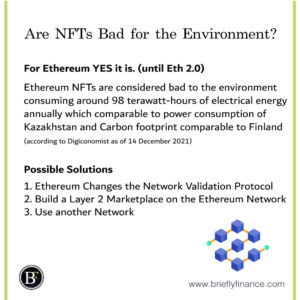You may have came across articles and people discussing how bad NFTs are for the environment. Is it true? The short answer is yes it is bad if you are using the Ethereum network which is the most popular and the one we will focus on this post.
Ethereum transactions are considered bad to the environment consuming around 98 terawatt-hours of electrical energy annually which comparable to power consumption of Kazakhstan and Carbon footprint comparable to Finland (according to Digiconomist as of 14 December 2021). However, there are three possible ways to solve this issue.

Attribution: The icons has been designed using resources from Flaticon.com
Then why don’t NFTs users just move to other network and conserve energy? There are networks like Solana and Cardano that consumes way much less energy and layered marketplaces like immutable X that also conserve energy. However, Ethereum is just too big with market capitalisation of around $450 billion (14 December 2021), its reliable it’s the most well-known (much are being sold in opensea.io) and its heading towards the right direction (eventually).
How is NFT bad for the Environment?
To put it into perspective, a digital artist called Memo Akten has found from researching 18,000 NFTs that the average NFT transactions has a carbon footprint equivalent to more than a month of electricity usage for the average person living in the EU.
A single Ethereum transaction consumes around 214 kWh (according to Digiconomist as of 14 December 2021). That is equivalent to 7 days power consumption of an average US household.
OK I Know it may still seem unclear about what is kWh…
A one kWh is equivalent on using a 1,000 watt appliance for one hour here are some examples they provided.
- A 100 watt light bulb would take 10 hours to rack up 1 kWh
- A 2,000 watt dishwasher would use 1 kWh in just half an hour
- Running an electric shower (10,000 watts) for 6 minutes
- Keeping an immersion heater (3,000 watts) on for 20 minutes
- Cooking in an oven (2,000 watts) for 30 minutes
- Using an iron (1,000 watts) for 60 minutes
- Using a laptop (20-50 watts) all day
And finally, one Ethereum transaction is 214 kWh…
I came across the above information from an energy supplier website called ‘OVO’ good details about the electrical energy consumption.
Why does it cost so much energy?
As a decentralised network, there is no one server/computer that allow a transaction to follow through. What happens in the blockchain is there are multiple of servers/computers competing to validate the transaction to be rewarded with profit (the gas fee).
The validation process or as they call it protocol in the Ethereum network is causing the high energy consumption which is called proof-of-work. The validators/miners are competing with each other solving a mathematical equation where at the end of the day only one of all the servers/computers will be the winner.
All servers and computers running in blockchain around the world (validators/miners) are simultaneously consuming energy to solve this equation which consumes so much energy whereas the one that solves the equation gets rewarded with the gas fees.
What are the Possible Solutions?
- Ethereum Changes the Network Validation Protocol
When Ethereum will finally switch its network validation protocol from proof-of-work to proof-of-stake, the energy consumption will significantly go down and almost to zero.
So what is proof of stake? Instead of having miners compete for a transaction consuming lots of energy through. The proof-of-stake will randomly choose a a validator based on the proportion of Ethereum they staked (put aside) for the network.
This development is part of the Ethereum 2.0 upgrade that was planned since 2014. Here is a link of an article explaining the phases of this upgrade.
- Build a Layer 2 Marketplace on the Ethereum Network
Another solution to reduce energy consumption is to build another network above the Ethereum network (e.g. Polygon, and Immutable X).
This means, instead of a user making multiple NFTs transactions on the Ethereum network directly. There will be one approved transaction allowing the second layer using a gas free protocol like proof-of-stake to make them.
- Use another Network
Given the cryptocurrency/NFT is a highly adopted fast moving technology there are also another notable blockchains that already use proof-of-stake and are not bad to the environment like Solana and Cardano.
Final Thoughts
It is true Ethereum which is the main leading network that NFTs are adopted in is bad for the environment but with such a market cap of almost half a trillion there is definitely a pressure from the investors to solve this issue.
I am not sure if Ethereum will solve this issue fast (I hope they do), it is just very interesting time in the NFT space, it is a booming industry with many entrants (brands and users). We just still do not know which network or method will be the winner and acquire the mass audience.
Related Posts:
- Why are NFTs Expensive? 7 Reasons that Makes NFTs Valuable
- Are NFTs a Pyramid Scheme? 4 Reasons Why it Feels Like it
- Is NFT a Cryptocurrency? NFTs vs. Cryptocurrencies Explained
Disclaimer: Above links are affiliate links and at no additional cost to you. I may earn a commission. Know that I only recommend products, tools, services and learning resources I’ve personally used and believe are genuinely helpful and relevant. It is not because of the small commissions I make if you decide to purchase them. Most of all, I would never advocate for buying something that you can’t afford or that you’re not yet ready to implement.
